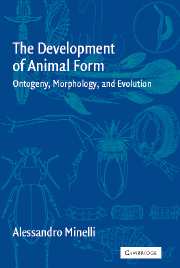Book contents
- Frontmatter
- Contents
- Preface
- Acknowledgements
- 1 The Nature of Development
- 2 Everything Begun to the Service of Development: Cellular Darwinism and the Origin of Animal Form
- 3 Development: Generic to Genetic
- 4 Periodisation
- 5 Body Regions: Their Boundaries and Complexity
- 6 Differentiation and Patterning
- 7 Size Factors
- 8 Axes and Symmetries
- 9 Segments
- 10 Evo-devo Perspectives on Homology
- Summary and Conclusions
- References
- Index
8 - Axes and Symmetries
Published online by Cambridge University Press: 10 August 2009
- Frontmatter
- Contents
- Preface
- Acknowledgements
- 1 The Nature of Development
- 2 Everything Begun to the Service of Development: Cellular Darwinism and the Origin of Animal Form
- 3 Development: Generic to Genetic
- 4 Periodisation
- 5 Body Regions: Their Boundaries and Complexity
- 6 Differentiation and Patterning
- 7 Size Factors
- 8 Axes and Symmetries
- 9 Segments
- 10 Evo-devo Perspectives on Homology
- Summary and Conclusions
- References
- Index
Summary
The essential unity of the phenomenon of Repetition of Parts and of its companion-phenomenon, symmetry, wherever met with, has been too little recognized, and needless difficulty has thus been introduced into morphology.
W. Bateson 1894: 21[Co-option] is the fundamental process by which evolutionary change in bilaterian form has occurred.
E.H. Davidson 2001: 164The Animal's Main Body Axis
Zoologists and lay persons alike would not hesitate in identifying the main body axis in animals such as an earthworm, a leech, a grasshopper, a fish, or a bird. However, difficulties will appear if one is asked to point to the main body axis of a sea star, a sea squirt, or a hydra.
What is an animal's main body axis? It is the longitudinal axis uniting the animal's fore and rear ends. The fore end coincides with the animal's head, where the mouth, brain, eyes, and other important sensory organs are located. The rear end, to the contrary, is reasonably identified with the site of the animal's anus and, perhaps, excretory and genital openings. In turn, the anterior position of both mouth and eyes, and the posterior position of the anus, correspond to the animal's polarity with respect to locomotion. The animal explores the environment with the aid of the anterior sensory organs and is ready to use its anterior mouth to exploit any food items its sensory organs might discover.
- Type
- Chapter
- Information
- The Development of Animal FormOntogeny, Morphology, and Evolution, pp. 142 - 187Publisher: Cambridge University PressPrint publication year: 2003



